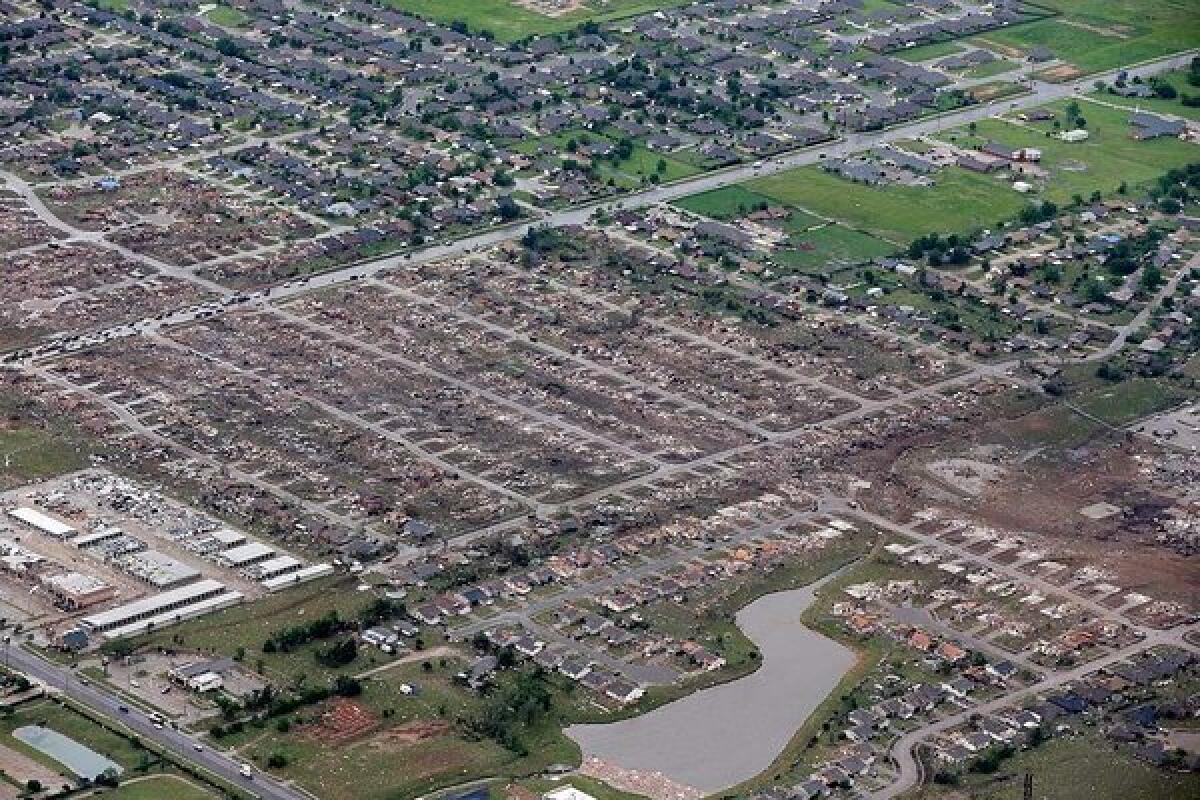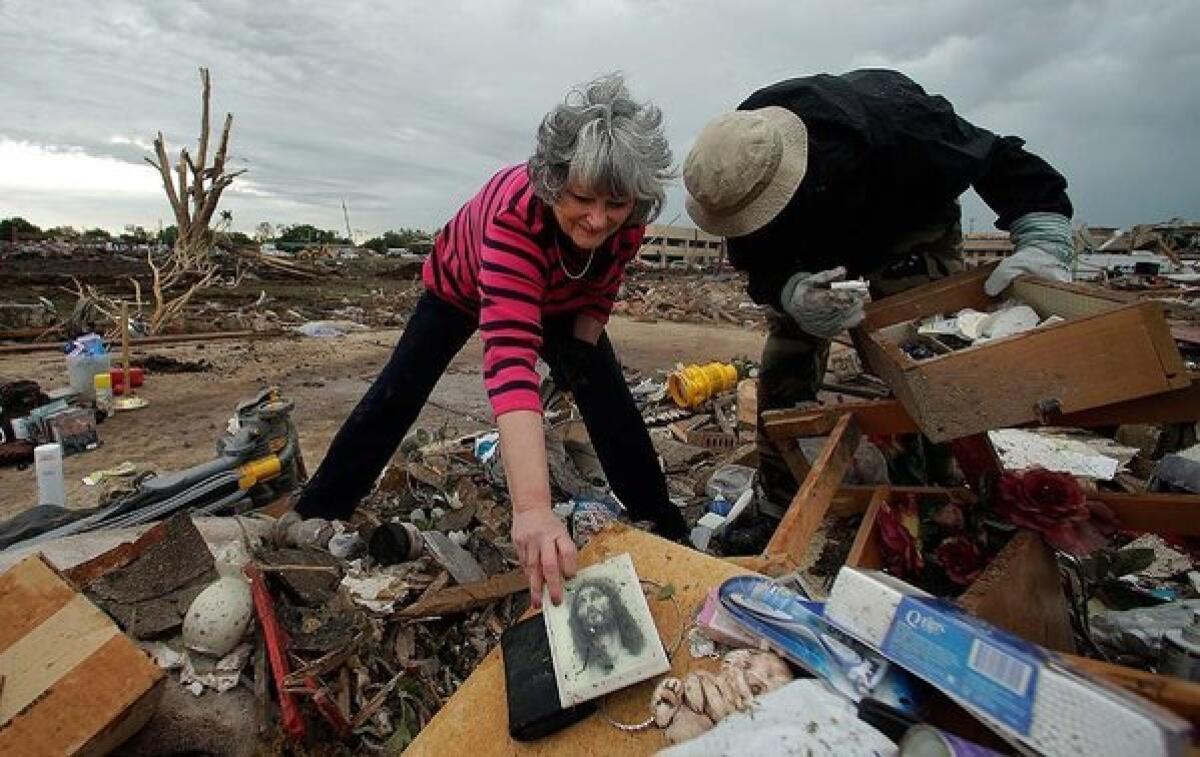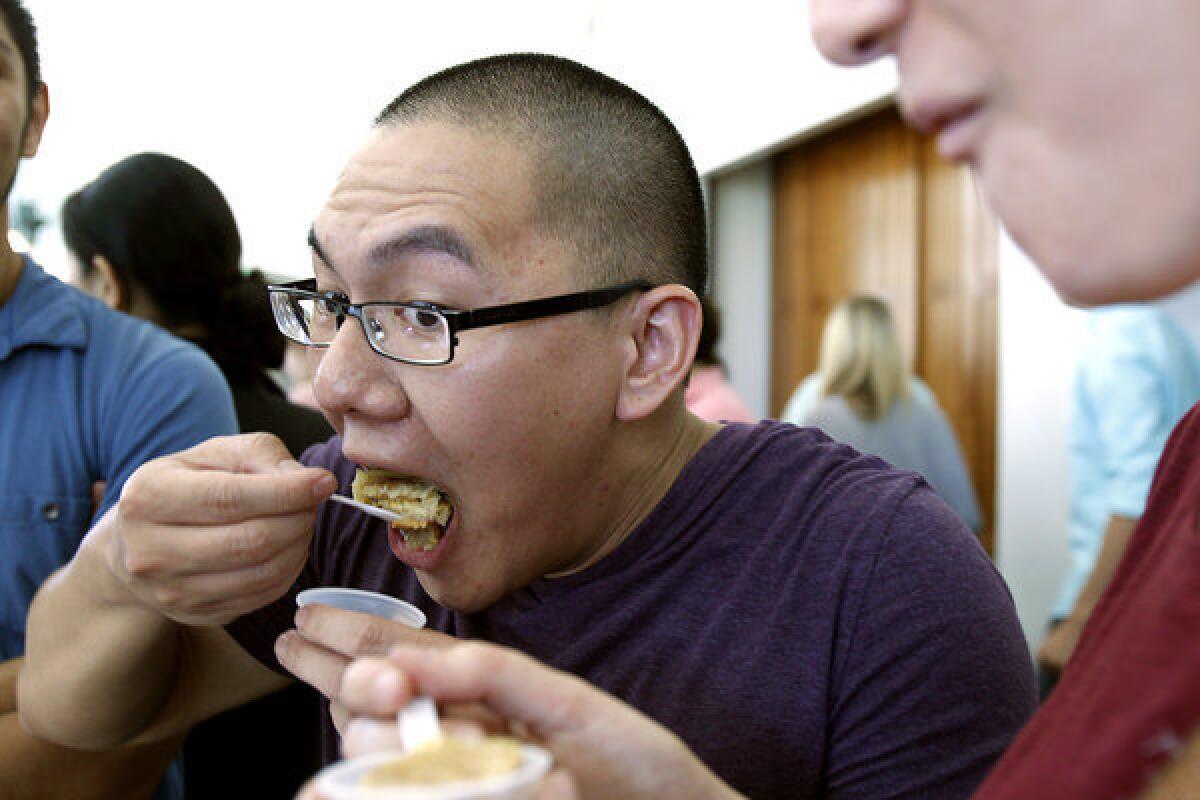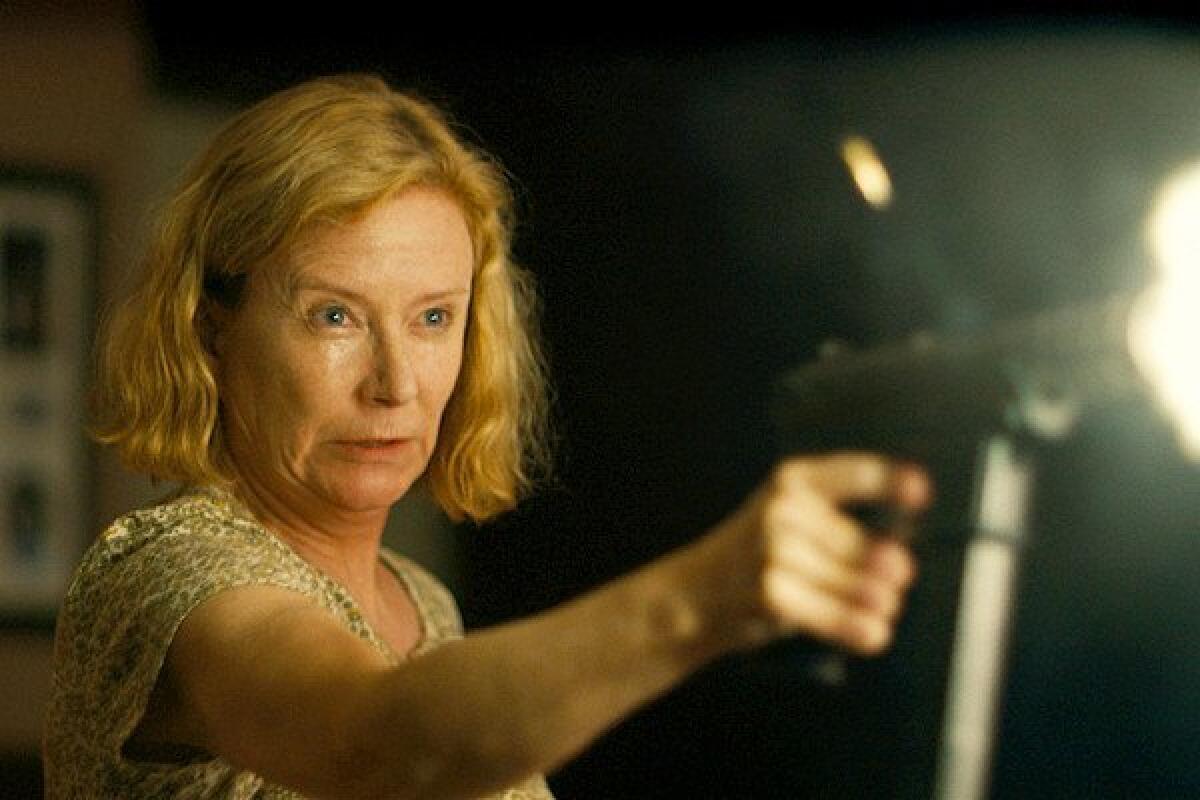Putting an Okie spin on twisters
In Tornado Alley, Oklahomans count on longtime TV meteorologist Gary England for life-saving information – and entertainment.
- Share via
Two days before the tornado hit, Gary England had an uneasy feeling. The wind patterns emerging over the weekend reminded him of the conditions that unleashed deadly storms in the region on May 3, 1999.
He began warning that trouble was just days away. England has been forecasting the state's often capricious weather for so long — 40 years — that when he says to seek shelter, they do.
Reporting from his post at KWTV Channel 9, the TV meteorologist watched on Monday as monitors showed a mammoth tornado, spun by 200 mph winds, ripping through the Oklahoma City suburb of Moore. Roofs, walls and chimneys hurtled through the air.
"Those are homes," he told viewers, his voice steady but tinged with sadness. "It's going through homes."
He then addressed those in the twister's path. "It is a life-threatening tornado," he said, reminding them what Oklahomans learn from childhood: that the safest place in a tornado is below ground. "Take your precautions immediately."
Monday's tornado left 24 dead and more than 12,000 homes damaged or destroyed. Scores of people were rescued. When Republican Gov. Mary Fallin singled out the heroes this week, she included the state's weathercasters, and England's been at it longer than any of them.
At 73, he has chronicled some of Oklahoma's most devastating storms in this part of the nation, known as Tornado Alley.
England got started in 1972, when he stood in front of cameras with chalkboards, not computer graphics, providing the visuals. He is credited with developing faster and more accurate methods of predicting tornadoes and often issues warnings before the National Weather Service.
"I've heard people say, 'Gary England saved my life,' " said Keli Pirtle, spokeswoman for the National Oceanic and Atmospheric Administration.
A popular Oklahoma City blog recently voted England the most influential person in the state; Jesus came in second.
In Oklahoma tornadoes strike fear, but they also help define the state's culture. A country station in Oklahoma City is 101.9 The Twister. The airport sells trinkets decorated with whimsical images of funnel clouds. People regularly ignore tornado watches, issued when conditions are right for a twister. But when one is sighted or imminent, they take notice.
Describing himself as an Okie living his dream, England also has a folksy and off-beat sense of humor and a persona that's pure country, sprinkling his reports with exclamations of gosh, good gracious, and great God almighty.
He calls computers and other high-tech equipment "rascals." Oklahoma City is "the big town" and menacing storms "the big uglies." He advises viewers without storm cellars to take shelter in a bathtub and cover themselves with blankets and "pillahs."
"The ability to take highly technical weather information and translate it into the way in which a rural Oklahoman who's running a wheat or cattle farm can understand is critically important," said Kevin Kloesel, director of the Oklahoma Climatological Survey, a state agency. "If you could call a language Oklahoman, Gary speaks it and invented some of the phrases for it."
For years England would do segments on the "thunder lizard," which he described as a 805-pound creature that changed color with the weather. It was completely fictitious, and viewers, in on the joke, called in with tongue-in-cheek reports about run-ins with the beast.
Lightning strikes during a thunder storm as tornado survivors search for salvagable items at their devastated home on Wednesday in Moore, Okla. (Jewel Samad / AFP/Getty Images) More photos
One night on Facebook he wrote one of his favorite lines: "Jump back, throw me down, Loretta, it's Friday night in the Big Town!" It's his way of expressing excitement, and his fans commented immediately. "I love you," one man wrote. "You are an inspiration to my life, and if I was a female, I would marry you."
At the parades, school assemblies and community picnics he attends throughout the state — he once rode a bucking bull in a rodeo — smiling fans clamor for him, shove babies into his hands, pose for photos and demand autographs.
His quirks are so familiar that in 2006 two University of Oklahoma students — one a self-described weather nerd — created the Gary England drinking game, now played statewide.
Among the rules: If England mentions Pottawatomie County, baseball-sized hail or the towns of Slaughterville, Weleetka or Mulhall, players take two drinks. If he says "mesocyclone," that's three drinks.
His crew of storm chasers who report from the field includes a young British man who saw England's tornado broadcasts and moved with his mother to Oklahoma because he wanted to work with him. A husband-and-wife team who started a ministry called StormTrackers for Christ have been sending him reports for more than a decade. He keeps the contact information for his 10 or so storm chasers, who receive modest stipends, in a white binder labeled "The Book of Knowledge."

But when the funnel clouds form, England is all business.
By 3:11 p.m. Monday he was reporting "total destruction to every home in [the tornado's] path. There goes another house." Two of his storm chasers, Val Castor and David Payne, called in to his broadcast, talking over each other.
"Gary, I see boards, I see roofs of houses," Castor said. "Everything is flying through the air."
"This is May 3, 1999, all over again," Payne said. He then echoed a warning England made then — a warning that's become famous throughout Oklahoma for its bluntness: "If you are not below ground, you will not survive."
"Oh, my gosh," England said.
England's performance during the 1999 storm helped cement his reputation as a trusted source on tornado news. As the twister approached Moore, which was also devastated by Monday's tornado, he said, "You need to be below ground level to survive."

An aerial view shows the tornado's path through a residential area in Moore, Okla. (Tony Gutierrez / Associated Press) More photos
The urgency in his voice that day prompted Lacey Swope's father to pack up the family and flee in the car. The family had no storm cellar.
Years later, Swope was interviewing for an internship at Channel 9, and promptly forgot her prepared answers when England joined the interview.
"I was star struck. I mean, he's a legend." She ran to her car afterward to call home. "Mom, I met Gary England!"
Swope, now 25, is a meteorologist who works with England at Channel 9. "He's seen the patterns so many times and he knows what's going to happen, and a lot of times, that's better than a computer model can do," she said.
England has been fascinated by the weather since he was a boy in Seiling, a speck of a town in western Oklahoma. Weather was entertainment, he said, even though "it scared the daylights out of [him] when it was storming."
As a child, he rode with his father on a bread truck route and, with a Brownie Hawkeye camera, photographed the towering storm clouds.
By the time he was in seventh grade, he would watch a 15-minute weather show every Sunday by Harry Volkman, one of Oklahoma's first television meteorologists. One day, he pointed to Volkman and told his father he wanted to be "one of those."
England left Seiling for the Navy because, through the military, he could attend weather school. After the Navy — 2 years, 11 months and 22 days, he says — he attended the University of Oklahoma.
Today, the university is home to the National Weather Center. But when he began in the fall of 1961, there wasn't even a meteorology degree. England earned a mathematics degree with a meteorology option.
After college, England and his wife, Mary, and infant daughter, Molly, spent a few years in New Orleans, forecasting oceanographic and meteorological conditions for A.H. Glenn & Associates, a private weather service. But England longed for a television career, and for his home state, where tornadoes continued to kill and people had little warning.

He got his chance in Oklahoma City at KWTV, though his first news director was bothered by the small-town weatherman's thick, western Oklahoma drawl.

Lea Bessinger salvages belongings as she and her son Josh sort through the rubble of her tornado-ravaged home in Moore, Okla. (Charlie Riedel / Associated Press) More photos
"We need to get Gary's voice fixed," England recalled the man saying.
"I was country," England said. "Every news director who came along tried to clean me up, and they never did."
He would laugh on the air. He told unscripted jokes and started talking about the thunder lizard. His ratings skyrocketed.
Forecasting technique were still developing, and severe storm warnings usually came too late.
"In the beginning, I would only warn Jane a tornado was coming because John's house blew away," he said.
At England's urging, KWTV purchased its first weather radar in early 1973. In the 1980s he became one of the first TV weathercasters in the world to use Doppler radar, which can detect precipitation and the speed and direction of wind to make forecasts.
With the Doppler radar, England often sounded the alarm before the National Weather Service's official warnings.
"I'm sure I must have mentioned on the air that we were ahead," England said. "I was a brash young man."
England was the keynote speaker when the gleaming new National Weather Center was dedicated in Norman in 2006. A few years later, as one staffer tells it, a group of elderly women was touring the building; they saw the giant globe suspended from the lobby ceiling, the Flying Cow Cafe, rooms of scientists peering at glowing radar maps.
But then they caught sight of England, who happened to be there that day. The women stopped listening to the scientists guiding the tour. They wanted Gary.
Follow Hailey Branson-Potts (@haileybranson) on Twitter
More great reads
Students ask, can science make a better apple pie?







